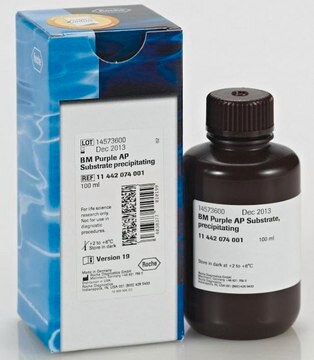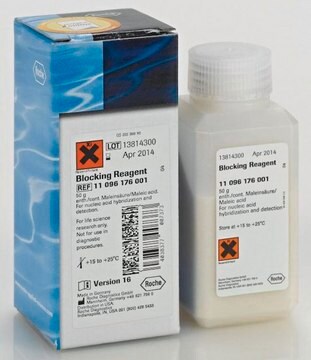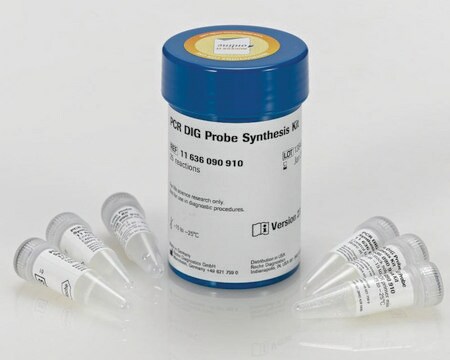11277073910
Roche
DIG RNA Labeling Mix
sufficient for 20 reactions, solution
Synonym(s):
nucleic acid labeling
About This Item
Recommended Products
form
solution
Quality Level
usage
sufficient for 20 reactions
packaging
pkg of 40 μL
manufacturer/tradename
Roche
impurities
Ribonuclease, none detected (up to 20 µl using MSII-RNA)
color
colorless
solubility
water: miscible
storage temp.
−20°C
General description
Assay Time: 135 minutes
Sample Materials
Linearized plasmid DNA:
The DNA to be transcribed is cloned into the polylinker site of an appropriate transcription vector which contains adjacent to the polylinker a promoter for SP6, T7 or T3 RNA polymerase. For the synthesis of ‘run off′ transcripts the plasmid is linearized by a restriction enzyme. Restriction enzymes creating 5′-overhangs should be used; 3′ overhangs should be avoided. The linearized template DNA should be purified by phenol chloroform extraction and ethanol precipitation, to avoid RNase contamination. For ′run around′ transcription circular plasmid DNA is used.
PCR product:
PCR-fragments which contain RNA polymerase promoter sequences can also be used as templates for transcription. Purification of the PCR fragment by HighPure column purification prior to transcription is recommended.
Convenient nucleotide mixture for the labeling of RNA with Digoxigenin-11-UTP.
Contents
10x solution with: 10 mM ATP, CTP, GTP (each), 6.5 mM UTP, 3.5 mM DIG-11-UTP.
Specificity
Application
- Northern blots
- Southern blots
- Dot blots
- Plaque or colony lifts
- RNase protection experiments
- Chromosomes, cells, and tissue sections in situ
Features and Benefits
Quality
Other Notes
Signal Word
Warning
Hazard Statements
Precautionary Statements
Hazard Classifications
Acute Tox. 4 Oral
Storage Class Code
12 - Non Combustible Liquids
WGK
WGK 1
Flash Point(F)
does not flash
Flash Point(C)
does not flash
Certificates of Analysis (COA)
Search for Certificates of Analysis (COA) by entering the products Lot/Batch Number. Lot and Batch Numbers can be found on a product’s label following the words ‘Lot’ or ‘Batch’.
Already Own This Product?
Find documentation for the products that you have recently purchased in the Document Library.
Customers Also Viewed
Articles
Digoxigenin (DIG) labeling methods and kits for DNA and RNA DIG probes, random primed DNA labeling, nick translation labeling, 5’ and 3’ oligonucleotide end-labeling.
Protocols
Determine the labeling efficiency in terms of μg (expected yield of a standard labeling reaction is 20 μg of DIG labeled RNA per μg linearized template DNA after the DIG RNA labeling reaction).
Our team of scientists has experience in all areas of research including Life Science, Material Science, Chemical Synthesis, Chromatography, Analytical and many others.
Contact Technical Service






